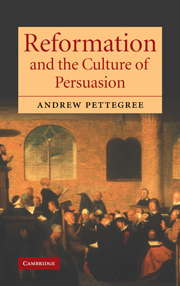7 - Pamphlets and persuasion
Published online by Cambridge University Press: 04 December 2009
Summary
On the basis of the foregoing discussion we can now be reasonably satisfied that the production of books in the sixteenth century was deeply shaped by the organization of the market – both the structure of the printing industry, in a series of discrete and quite distinct national markets, and a sophisticated transnational system of distribution and marketing. These industry issues conditioned the book world at all levels: the market in scholarly books, as much as the production and sale of pamphlets. Our purpose now must be to try and locate the book in the culture of persuasion.
There can be little doubt that books had a vast and important role to play in shaping the new religious cultures of the sixteenth century. Books were bought in vast quantities, and religious books dominated the market at all levels: at both ends of the spectrum and almost all points in between. From the learned Latin biblical commentaries of Calvin, Brenz and Oecolampadius, to the ‘godly ballad’, with a whole host of Bibles, catechisms, works of devotion and Flugschriften in the middle ranges, the market in religious books dominated the sixteenth-century book world. None doubted their impact in forming opinion – certainly not Luther and his colleagues, who wrote so indefatigably and lavished praise upon the ‘new’ invention; certainly not the Catholic authorities who tried to limit their circulation by censorship and proscription. But in some senses the book has suffered precisely because its influence seems so obvious.
- Type
- Chapter
- Information
- Reformation and the Culture of Persuasion , pp. 156 - 184Publisher: Cambridge University PressPrint publication year: 2005

